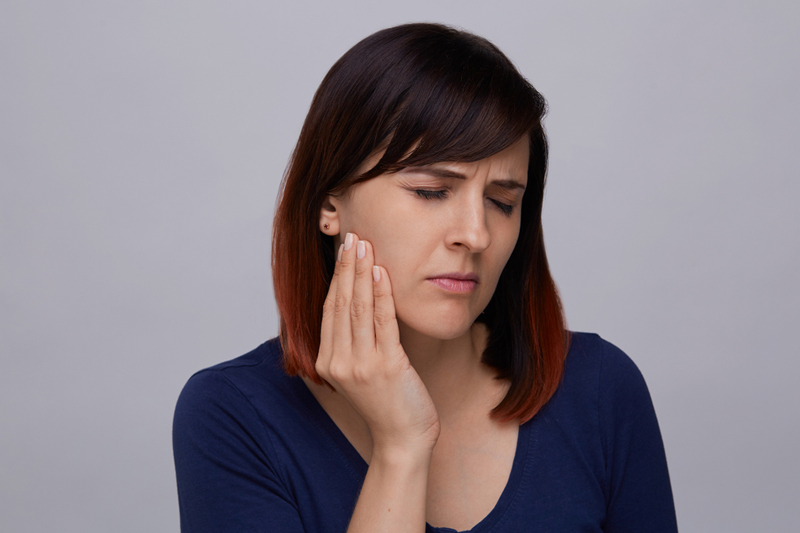Explore Treatments for TMJ Disorder in Chino

What is TMJ/TMD?
TMJ or the Temporomandibular Joint is the joint that connects the lower jaw (mandible) to the temporal bone of the skull, which is immediately in front of the ear on each side of your head. The joints are different than any other joint in your body because the mandible leaves the socket and slides forward when you open wide. No other joint in your body functions in this manner. Muscles attached to and surrounding the jaw joint control the position and movement of the jaw. A disk-shaped cushion sits between the lower jaw and the skull to allow for movement without having bone sliding or grinding against bone.
TMD or Temporomandibular Disorder is the name given to the conditions that negatively affect the joint. Many clinicians and patients use the terms TMJ and TMD interchangeably. Because the TMJ is the most complex joint in the body, many different factors can contribute to its dysfunction. TMD can include problems with muscle, bone, ligaments and other tissues that surround the TMJ.
Signs and Symptoms of TMD:
- Pain is the most common symptom that initiates patients to seek treatment. The pain can be temporary or may last for several years. The pain can be associated with the face, joint area, ears, temples, teeth, shoulders or neck.
- Inability to open your mouth very wide. This symptom is commonly seen when a patient is seeing the dentist for treatment and has to hold their mouth open for a long period of time.
- Jaw that gets locked in the open or closed position. This can occur while yawning or even clenching your teeth.
- Clicking, popping, or grinding sounds in the jaw joint when opening or closing the mouth.
- Sore jaws after chewing. This is evident if the patient cannot chew gum for more than ten minutes without becoming tired and sore.
- Difficulty chewing hard food.
- Ringing in the ears or Tinnitus.
What Causes TMD?
While there is no single cause of TMD, there are a number of factors that can trigger symptoms of the condition. These causes include:
- Nighttime clenching or grinding known as bruxism can cause morning headaches. Patients do not always know they are doing this because they are asleep.
- Muscle misalignment or malfunction can cause pain, leading to TMJ-related pain.
- The disk or cushion that is seated on top of the condyle (top portion of the lower jaw) can become damaged or displaced. This causes the bone of the jaw to grind directly on the bone of the skull, trigger TMJ disorders and causing pain.
- Trauma to the jaw can create immediate symptoms that can easily be diagnosed. However, the effects of facial trauma can also lead to long-term joint deterioration, preventing symptoms from appearing for several years.
Diagnosis of TMD:
Clinicians with extensive experience in treating TMJ disorder have many ways in which they can identify the cause of joint dysfunction. When examining patients with suspected TMJ disorder, our Chino dentist uses the following techniques:
- Collect a detailed history of your symptoms.
- Listen to and feel your joints as you open and close your mouth.
- Determine your range of motion.
- Palpate areas around your jaw and head to determine areas of pain or discomfort.
- If we suspect a problem with your teeth, you may need X-rays. A CT scan may be recommended to provide detailed images of the bones involved in the joint, or an MRI to reveal problems with the joint's disk..
Explore your Treatment Options with Gavrila Dental
Due to the complexity of the TMJ, there are many different types of treatments. The importance of a clear and concise diagnosis cannot be overstated. If you suffer from long-term symptoms, taking pain relievers is not the answer. The cause of the dysfunction needs to be determined so that the proper treatment can be prescribed.
At our Chino dental office, our dentists offer the following treatment options for TMD and related jaw-pain disorders:
Occlusal Appliances
The term occlusal refers to the biting surfaces of the teeth. There are many types of occlusal appliances that are used to treat TMJ disorders. These appliances are usually made of clear acrylic and they alter the way the teeth fit together and the position of the jaw. This type of treatment is widely used because it is reversible.
Occlusal Adjustment or Equilibration
If it is determined that your bite is causing your TMJ symptoms, an occlusal adjustment may be necessary. The biting surfaces of the teeth are recontoured to fit and function without stressing the TMJs. We will take impressions of your teeth and use instruments that mimic the movements of your jaw so we can determine if occlusal adjustment is right for you.
Orthodontics
If the position and fit of your teeth are causing TMJ symptoms, you may need orthodontics. This therapy can be prescribed if we determine that the teeth are not fitting together properly but an occlusal adjustment cannot be performed.
Surgery
Surgery is used to treat only the very worst cases of TMJ disorders. In cases that have a bone or disk derangement that has degraded the joint to a point that the patient cannot function, surgery may be the only option. The types of surgery vary from scoping to complete joint replacement.
Relieve Jaw Pain Today - Contact Gavrila Dental in Chino
Our dentists at Gavrila Dental are conveniently located in the San Bernardino - Riverside area and want to get you out of pain fast! Contact our Chino dental office for a consultation today!


 Review Us
Review Us Review Us
Review Us